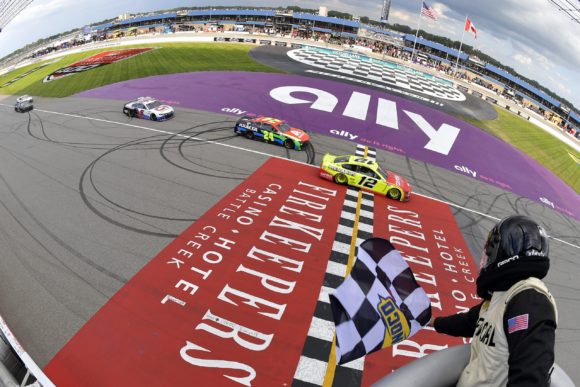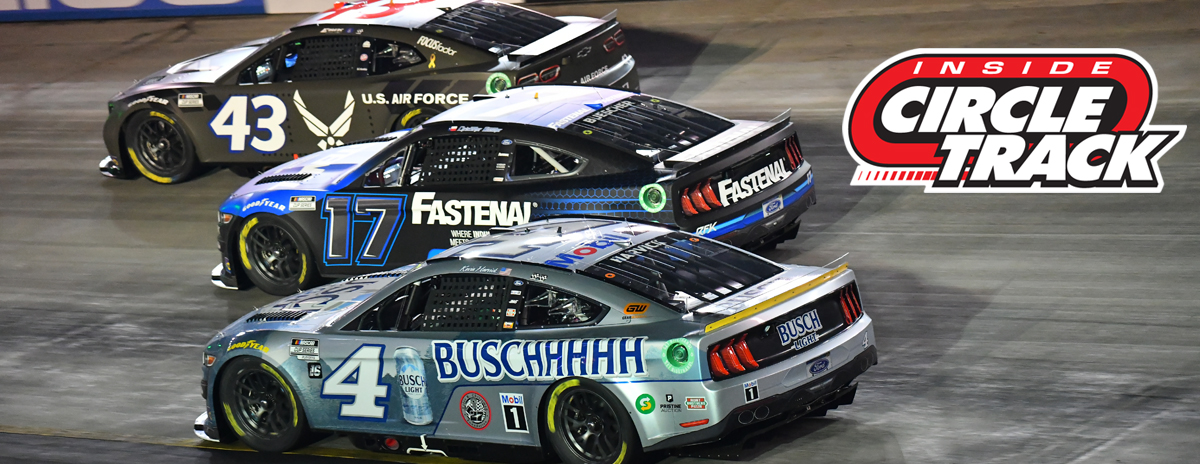
The 550 package lends itself to close finishes(Photo: Getty Images)
The FireKeepers Casino 400 held on Sunday at the Michigan International Speedway clearly illustrated exactly how the 550 horsepower/high downforce package is supposed to work. And some comments made after the race seemed to show exactly who that package is meant to attract.
Much of the 400 miles contested on Sunday featured cars racing in close quarters with one another and even, from time to time, coming in contact with each other or bobbling briefly after losing downforce when getting too close to another. But on the flip side of that close racing was the fact that this particular package makes it extremely difficult for drivers to complete passes despite the fact that it induces side-by-side competition.
The 550 package is meant to have drivers racing in packs in somewhat the same way they do at tracks such Daytona and Talladega. On Sunday, it did, in large part, accomplish what it was meant to do, especially within the first few laps of restarts.
The problem with all of this is that there is a debate regarding the “purity” of the racing caused by taking away a great deal of horsepower from the cars while at the same time adding a significant amount of downforce. Essentially, drivers can run flat out or near flat out all the way around the 1.5-mile tracks such as Charlotte, Texas and Atlanta as well as the 2-mile layout in Michigan.
Many racing purists are very much opposed to the low horsepower/high downforce manner of competition. They often argue that true racing has been sacrificed for the sake of entertainment by artificially keeping cars bunched together. These fans say that this type of manufactured competition may allow the luckiest to win rather than the best.
The flip side of that argument comes from those in favor of keeping the cars close so that fans can be entertained for the full race distance. Those in favor of this type of racing will say they would rather watch cars battle in close proximity to each other rather than get strung out all the way around a big track while logging lap after lap.
After Sunday’s race ended, former driver and now NBC commentator Kyle Petty mentioned how the action on display Sunday in Michigan lends itself to the tastes of newer fans.
“If you’re a casual fan, you loved this race,” Petty declared. “You could throw a blanket over the top-4 all day.”
To further make Petty’s point, a colleague of mine who is a casual race fan stated on Monday morning that he only saw the last ten laps of the race but enjoyed watching the cars run that close together.
However, race winner Ryan Blaney pointed out that having so little horsepower and so much downforce causes drivers to rely much more on strategy and help from others as aerodynamic factors are brought more into play. And while this might not be his favorite way to race, he was happy to score his second win of 2021.
“Yeah, got a great push by the 18(Kyle Busch) on the restart, was able to get clear there,” the Team Penske Ford driver explained. “Michigan is a matter of pretty much running wide open and trying to play the air game. I hate you have to race that way. That’s how you have to run. Worked out for us.”
If you like the notion of the best car using superior handling and horsepower to separate itself from the pack, the current form of racing on the bigger tracks may not be for you. But, if you prefer packs of cars racing in close quarters throughout most of the day, today’s NASCAR is likely to be your thing.
With the coming of the NextGen car and its spec nature in 2022, it would seem likely that the latter will be the way of things for the foreseeable future.
Richard Allen is a member of the National Motorsports Press Association
Respond to this piece on Twitter –> @RichardAllenIDR
or on Facebook –> InsideCircleTrack/Facebook
